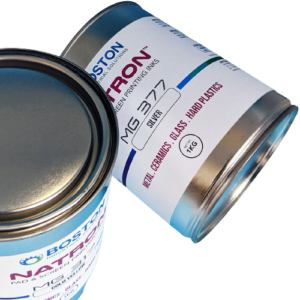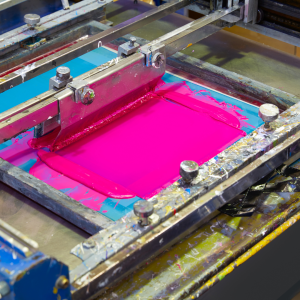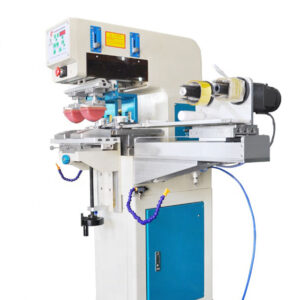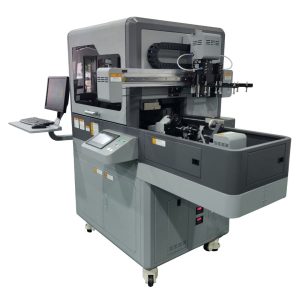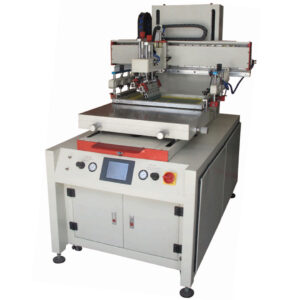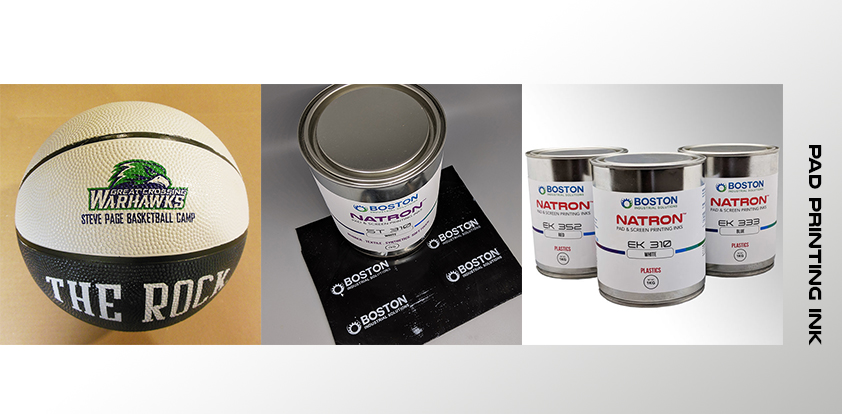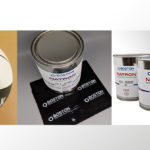Pad Printing ink explained
To get a perfect print, you need a perfect pad printing ink. Boston Industrial Solutions provides an easy guidance for finding the best solvent-based pad printing ink. Our Natron series inks have perfect adhesion on-to your substrates. For more information on our Natron Ink Series, visit our pad printing inks.
Visit our Learning Center for Compliance, and Technical Data documentation.
Pad Printing process
Pad printing is a printing process that transfers a 2-D image onto a 3-D object. The pad printing process is also known as tampography or tampo printing. Over the past few decades, pad printing has spiked in popularity for use on promotional items and apparel. The pad printing process sometimes referred to as tampography, transfers a 2-dimensional design onto a 3-dimensional object.
Why pad printing? Cost is a major advantage for Pad printing compared to other printing methods. Also, the machines are cheap, less complicated and last longer than other methods. In addition, pad printing equipment are easier to set up and operate. Lastly, pad printing requires less training and experience to be up and running.
Because of its versatility and the ability to printing on difficult to print objects, pad printing has gained popularity. Typical applications include medical, automotive, promotional, textiles (tagless), electronics, as well as toys.
To pad print, you need a machine. The printing machines require:
- an image etched onto a cliché (pad printing plate),
- a doctoring mechanism, typically an ink cup or a doctoring blade or a squeegee, and
- a printing rubber pad (tampon) usually made of silicone rubber.
The ink cup moves across the plate and floods the etch with ink. The ink cup ring then removes the excess ink from the etch. The silicone pad picks up the ink and transfers the image onto the substrate. This is how pad printing transfers a 2D image onto a 3D product. For every new artwork, you need a new printing plate. Also, for every color added into the design, a new plate must be etched. For example, a 2-color logo artwork would require 2 printing plates (clichés) to be etched.
Additional Resources:
Pad Printing explained
Cool things you can do with pad printing
About Inks
In simple language, an ink is a liquid or paste containing dyes and pigments, used for marking a surface. There are inks for writing, painting, spraying, toners, and in our case pad printing. In general you’ll find thicker inks in letterpress and lithographic printing.
The composition of inks is complex. Simply, inks have dyes, pigments, solvents, lubricants, resins, surfactants, fluorescers, and other materials. The components of inks are responsible for many purposes. These include color, carrying, viscosity, thickness of ink, and its appearance when dry.
Pad Printing Ink
Pad Printing ink is utilized to stamp or embellish parts. Different types of substrate requires different types of ink. The ink comes in different chemical compositions to match the substrates.
To get a perfect print you need the perfect ink for your specific substrate. There are thousands and thousands of substrate. Manufactures create them on a daily basis. Examples of different substrates are pens, pencils, fidget spinners, silicone wristbands, mugs. To print each of these products you need an ink that’s right for each substrate.
We formulate our inks from carefully selected pigments, resins, and binders. This tradition ensures that our inks work perfectly with your substrate.
Our solvent screen-printing and pad printing inks are either one or two part inks. 1-part or 2-part are also referred to as 1-component or 2-component. These terms are interchangeable.
A 1-component ink is an ink that does not require a cross-linker to work. It only needs a solvent to alter viscosity. For most our inks you need to add 5 – 15% solvent into the ink before printing. On the other hand a A 2-component ink needs a cross-linker (hardener). Different inks require different hardeners. We recommend the hardener be 10% of the inks weight. While the ink mixing process is simple, it very crucial to print quality, adhesion, and print durability.
Pad Printing Hardeners
Hardeners are also known as catalyst or cross-linker. A hardener is a chemical substance added to ink in order to harden it. The hardener makes the print more abrasion resistant. When mixed with the ink the hardener takes the color of the ink irrespective of the hardener color. Some hardeners are brown others are clears.
After printing, the hardener mixes with the ink, allows for better ink adhesion. It is also left as part of the print unlike the solvent which evaporates.
The work of the hardener is to improve print durability and long-lasting designs. Like our solvents, different inks use different hardeners. Different pad printing applications need different ink-to-hardener ratios. One component inks don’t require hardeners. Two component inks ratio can range from 3%-30% of the inks weight.
Adding a hardener to the ink triggers a chemical reaction. This reaction alters the ink pot-life. Pot life is the amount of time it takes for an initial mixed viscosity to double, or quadruple for lower viscosity state. An effect of adding catalyst is to the ink is reducing the pot-life. To increase pot-life of the ink, add solvent.
Pad printing solvents
A solvent a liquid used for dissolving other substances. In Pad printing process, a solvent alters the viscosity of the ink. It also aids in improving inks adhesion onto a substrate. The inks that we manufacture are solvent-based. As a result, the inks need a solvent for them to be usable for the printing process.
Different solvents have different evaporation rates. The evaporation speeds are slow, medium, fast and super fast. This is important to note because the solvent acts as the ink carrier during pad printing. When pad printing, the solvent evaporates out of the ink mixture, making the ink tacky. The enables the release of the ink from the silicone pad onto the substrate.
To make it easy for our customers, we offer several different pad printing solvents for our ink lines. For example, our SF will work with all our printing inks. However, TRM and SS will only work with the silicone inks.
Another key factor to consider when selecting a solvent in the printing environment. Dry environments should consider medium to slow solvents. Humid environments should consider medium to fast solvents.
Additional resources
How to select Pad Printing Ink
Understanding the composition of the substrate. This is first step to selecting the right pad printing ink. If you are not sure or are unable to, we have a free lab dedicated to substrate identification. Prior to mass production of your part, we always recommend testing adhesion testing.
Ink adhesion is affected by many things. No one ink will work on all substrates.
Other factors to consider when selecting an ink include:
- special surface coating,
- abrasion, chemical, requirements,
- out door, UV resistance , etc.
How to Mix pad printing ink
What is Silicone Ink?
Silicone ink is a special ink for printing on silicone rubber substrates. Current methods for printing with silicone are screen printing, spraying, or pad printing.
It is hard for ink to adhere onto silicone rubber. This is because of silicone’s unique characteristics. Most common types of silicone are tin-cure and platinum-cure silicone. This bring more complication for decorating silicone. Tin-based silicone cannot be printed with platinum based silicone inks. The reserve is also true.
To decorate silicone we have to follow the law of printing onto silicone. This law states that only silicone based ink will adhere on-to silicone substrate depending on the type of silicone cure.
Silicone ink is made of silicone. The SE Series is a 2-component ink that requires heat to dry and cure. Once the ink is fully cured, it becomes part of the product, it will never come off for the life of the product. It has extreme flexibility, chemical, abrasion, UV resistant.
Additional Resources:
How to print on Silicone wallets
Silicone Printing: Pad Printing vs. Screen Printing
Top 7 Ink Applications for Printing on Silicone with Silicone Ink
Learn more about Silicone Ink
Drying pad printing inks
A dry printed ink does not mean that it can withstand adhesion testing. To dry pad printed ink use heat or air drying process. Most pad printing inks will dry to touch within 20 minutes. However, full cross-linking between the ink and the substrate will not have occurred.
Full cross-linking is also known as curing. For a printed to air cure, it takes 12 – 72 hours. This depends on the substrate and print environment. Heat cure takes about 10 – 30 minutes on average. Test adhesion on printed products after full cure . Note: the hardener will continue to get harder over time.
Large production can automate and increase drying time by using dryers. Pad printing ink drying ink speed depends on the ink, substrate and print environment.
Ink Color-Matching
Color matching is the process of transferring a particular color across different substrate. In pad printing, color-matching is matching a color of a wet or dry sample to a pantone color card. This results in a custom color. For customers who need custom color, they can reference a specific pantone color and we will make it. Alternatively, wet samples or substrates are acceptable.
We use sophisticated tools to make sure colors are accurately made. We also offer mixing colors for customers looking to do in house color matching. Along with the mixing series we provide a database with ratios to mix your perfect custom color.
Pad printing ink adhesion testing
We test printed samples following ASTM industry standard. Each sample we get from our customer undergoes through rigorous abrasion resistance test. Do crosshatch, machine, tape, chemical and even real world wear and tear.
Ink compliance
Different industries have different compliance certification requirements. In general, use of the product will determined they type of certification.
Standard testing requirements that pad printing inks should comply with include:
Restricted Substances List (RSL) and lab tests. Most major companies have their own RSL that correspond to their production standards. Major restricted items in inks are lead, cadmium, mercury, and phthalates.
Class VI certification & USP-mem certification. These are medial certifications. Class VI is a common shortcut designation for medical-grade safety. Inks compliant these standards means that they meet strict medical safety standards. These type of inks can print on products that used in the human body.
The Consumer Product Safety Improvement Act (CPSIA). This test requires regular periodic testing of ink; once a year. This test confirms the absence of phthalates and lead content in the inks. All our inks go through these tests. This confirms we are compliant with industry standards and regulations. Safety is very important. We work hard to make sure all our inks are safe to use, especial for products that print on children products.
Textile industries use Eco Passport by Oeko-Tex®. This is an independent testing and certification system for chemicals, colorants and auxiliaries. This testing protocol is specific for textiles designed to be in contact with human skin.
Our Pad Printing Inks
For an overview information on our pad printing inks, check out the Pad printing ink Overview article.


